
|
|

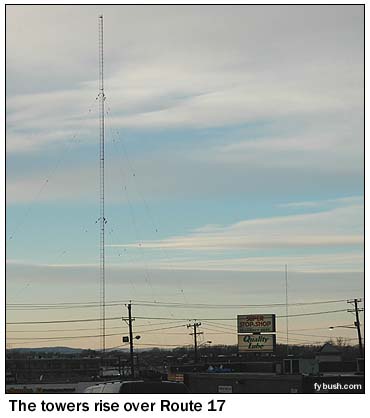 May 27, 2005
May 27, 2005
77 WABC, Lodi, N.J.
By SCOTT FYBUSH
As Tower Site of the Week gets ready for Memorial Day 2005, we're looking forward to an event that's become an annual tradition for fans of classic top 40 radio: WABC Rewound, 12 hours in which New York's WABC (770) sheds the talk format it's had for several decades and plays classic airchecks from its golden age as the nation's biggest and most important top 40 radio station.
No radio station ever had the listenership that "Musicradio 77" enjoyed from 1960 until 1982, and it's a safe bet that in today's fragmented media world, no radio station ever will again.
So this Memorial Day, we're delighted to be able to take you inside our February 2005 visit to the site on the south side of Route 17 in Lodi, New Jersey from which all that great radio beamed out to the tri-state area and far beyond.
As always, we begin with history: before it was WABC, this was WJZ, one of the area's first radio stations. WJZ began its life in 1921 as Westinghouse's Newark station, moving across the river two years later as part of the newly-created RCA, which operated the station from Aeolian Hall on West 42nd Street in Manhattan. Its transmitter returned to New Jersey in 1925, when the station built a transmitter plant in Bound Brook, in Somerset County some 30 miles from Manhattan. (UPDATE: It has subsequently been pointed out to me that the site was actually in Piscataway Township, in nearby Middlesex County, though Bound Brook was the nearest post office.) WJZ became the key station of the NBC Blue network in 1927, and by 1935 was running 50,000 watts full-time on 760 kHz from Bound Brook. The next year, NBC built a 640-foot tower at Bound Brook (some accounts indicate that it was a diamond-shaped Blaw-Knox, though I've never seen a picture to confirm that story), but it wouldn't stay there long.
In 1943, WJZ's new owner Edward Noble (who bought the station and the Blue network from NBC when it was compelled to shed one network) received FCC permission to move the transmitter to Lodi. (UPDATE: The move was directly related to NBC's sale of the station. Since NBC/RCA's shortwave transmitters were still located at the Bound Brook site, the company wanted to retain Bound Brook - especially since those shortwave transmitters had been conscripted for the war effort. The shortwave facility would be decommissioned after the war, and the site is now a housing subdivision.) WJZ briefly operated at reduced power from what's described as an "existing site" in Kearny (diplexed, perhaps, with WNEW or WMCA?) before signing on from Lodi on January 2, 1944.
The Blue Network became ABC not long afterward, and in 1953 WJZ took the new calls WABC. (New to 770, of course, but not to New York radio; those had been the calls of CBS' flagship station, now WCBS 880, from 1924 until 1946.) But the new WABC would linger in relative obscurity for a few more years until the Musicradio era began. But ever since - 22 years of top 40 and 23 years and counting of talk since then - it's been a giant.
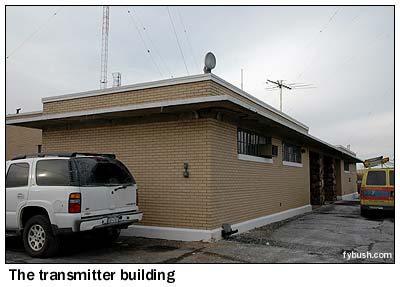
|
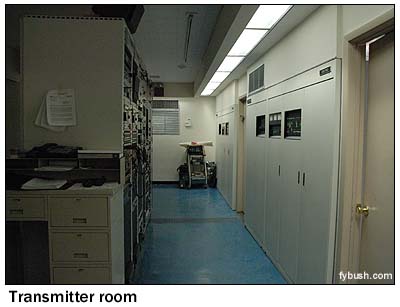
|
The 648-foot tower that went up in Lodi in 1943 (there have been claims that it was the same tower that stood in Bound Brook, but I don't believe that to be the case) is a prominent landmark along I-80, US 46 and Route 17, but the actual entrance to the site is an inconspicuous driveway amidst the sea of gas stations, warehouses and strip clubs that line the south side of 17. (The "Satin Doll," just up the road from the site, was seen in The Sopranos as the "Bada Bing.")
Get past the gate, and you're right in front of the squat brick transmitter building. Walk inside, and just beyond a narrow entrance hall a row of glass windows open on the transmitter room in all its glory.
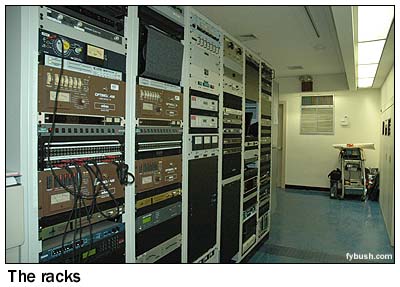
|
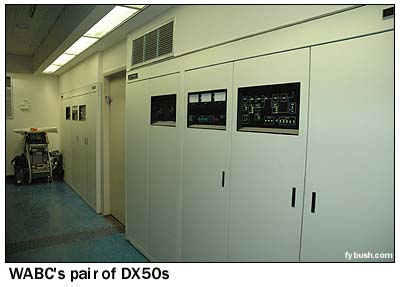
|
When my tower-photography colleague Jim Hawkins visited this site in the 1960s (as chronicled on his WABC Transmitter Page), those windows looked in on a far wall that held a General Electric BT-50A on the left and a Continental 316B 10 kW backup transmitter on the right, with a control panel sitting in the center of the room.
Today, the middle of the room is occupied by racks full of audio processing gear, STL equipment, monitoring gear and patch bays. Where the BT-50A once sat, there are now a pair of Harris DX50s. And where the 316B once sat, there was later a Gates/Harris MW50. That MW50 and the GE (which entered backup service once the MW50 arrived) were the very transmitters that carried Musicradio 77 to the masses. The MW50, itself relegated to backup duty, was retired a couple of years ago and offered on eBay. At the time of our visit, it was sitting in two pieces in the back room, awaiting pickup and a move to its new home out West.
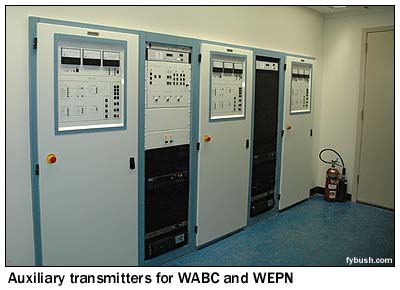
|
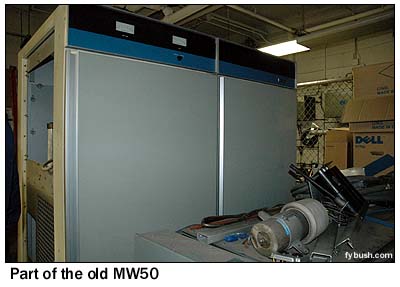
|
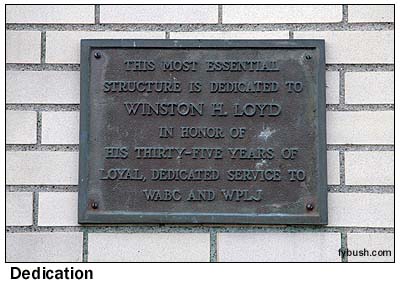 Where the MW50 once sat, there are now three Nautel
XL12 solid-state transmitters; two make up a backup for WABC,
while the third is an auxiliary for WEPN (1050).
Where the MW50 once sat, there are now three Nautel
XL12 solid-state transmitters; two make up a backup for WABC,
while the third is an auxiliary for WEPN (1050).
The rest of the building is unexciting; a few storage and office rooms in front, a big space in back that once held all the transformers for the big tube transmitters and is now used mainly for storage (it's also where the Harris DX10 transmitter that was used by 1010 WINS while its site in Lyndhurst was being rebuilt in 1994-95 was located), a dummy load cleverly mounted up near the roof, and of course generators for backup.
So from here, we head outside, down the long path that leads to the base of the big tower at the far corner of the property.
A substantial tuning house sits in front of the tower base, and careful inspection reveals a plaque on the front dedicating the building to longtime WABC/WPLJ engineer Winston Loyd, signer of innumerable WABC QSL cards for generations of DXers who listened to this huge signal across the proverbial "38 states and half of Canada" and far beyond.
Inside the door, we see the tuning network that was the last thing the WABC signal passed through before going out the window in back, into the tower and out to millions of listeners. With the lights off in the building, it's very neat to watch the fluorescent tubes flicker in time with Rush Limbaugh's voice. (Maybe we'll add the video to the page eventually...)
The tower base itself is behind a high brick wall at the back of the building.
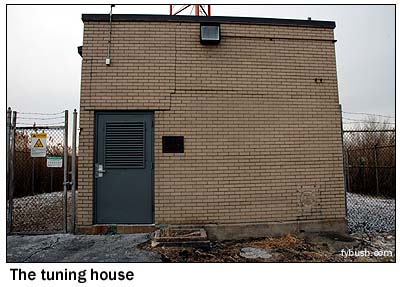
|
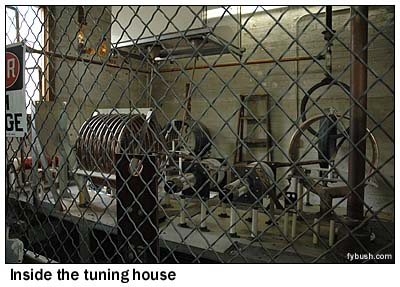
|
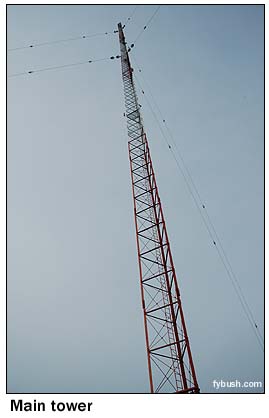
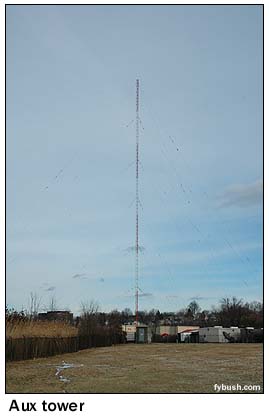 The tower looks pretty good for a 62-year-old
structure, and we take a few moments to stop and reflect on all
the voices and music that have emanated from that steel over
the decades. If that thing could talk...
The tower looks pretty good for a 62-year-old
structure, and we take a few moments to stop and reflect on all
the voices and music that have emanated from that steel over
the decades. If that thing could talk...
It's a short walk back across the open field to the 185-foot backup tower, erected in 1956. In addition to keeping WABC on the air during maintenance on the big stick, this tower has been a lifesaver for several other stations over the years. WNBC used it for a while after the 1967 plane crash that demolished its tower on High Island, and WINS used it for several months in 1994-95 while its site in Lyndhurst was being rebuilt.
(UPDATE: Dan Strassberg reminds me that the auxiliary tower was also used for several months in the fifties by WNEW, whose then-new 50 kW plant in Kearny had been severely damaged by a hurricane. Dan says several other stations also suffered severe damage from that storm, and that WHN and WAAT ended up sharing the auxiliary WOR transmitter in Carteret, alternating use of the facility for a few weeks until they could get their own plants rebuilt.)
It was recently reconfigured for use by WABC's sister station WEPN (1050), which can operate from Lodi with 12 kilowatts, non-directional, if construction around its main site in East Rutherford forces it to go off the air there.
(That would, however, be a temporary measure; contrary to the rumors that have floated around several message boards, there don't appear to be any long-term plans to make Lodi a permanent home for the 1050 signal.)
So there you have it: not the most glamorous or scenic site in America, by a long shot, but it's hard to imagine many transmitter sites that have the romance or history that WABC does. If you'll be spending your Memorial Day listening to "Rewound" (as we certainly will), now you, too, can say you've seen where it all came from back then.
And next week, we'll wrap up this look at the Meadowlands sites with a late-night visit to WABC's erstwhile top-40 rival, WMCA.
It's here - the 2005 Tower Site Calendar is now available at special clearance prices! Click here for ordering information!
- Previous Site of the Week: 1010 WINS, Lyndhurst, N.J.
- Next Week: WMCA 570, Kearny, N.J.
- Site of the Week INDEX!
- How can you help support Site of the Week? Click here!
- Submit your suggestions for a future Site of the Week!
